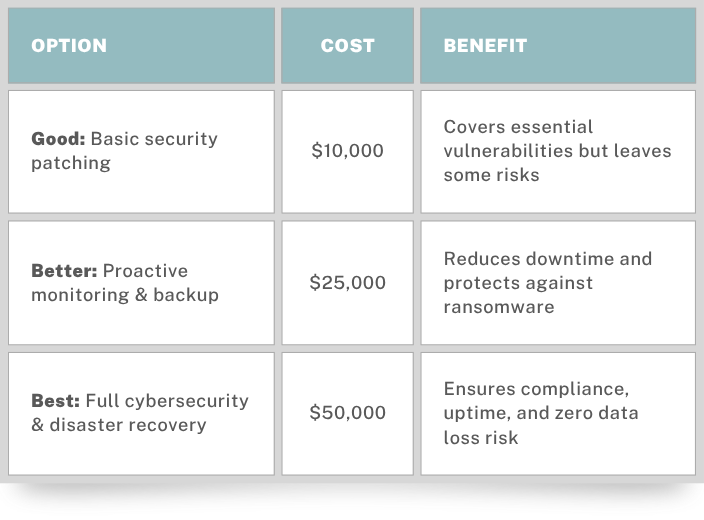Tactical Ways To Justify IT Spending, Prove ROI, And Avoid Pushback On Costs
The IT Budget Struggle Is Real
If you’re running IT for a growing company, you know the drill. You spend weeks crafting the perfect IT budget requests—outlining risks, showing how investments will improve security, and making sure everything is airtight—only to have leadership push back with, “Do we really need this?” or “Can’t we just stretch what we already have?”
Meanwhile, the CFO is looking for ways to slash expenses, and the execs still think IT’s main job is making sure the Wi-Fi doesn’t go down.
So how do you make them see IT for what it really is—a driver of growth, security, and efficiency—instead of just another line item to cut? You translate IT needs into business wins, risk mitigation, and clear ROI.
Here’s how you turn a budget rejection into a budget approval. Use these examples as a guide.
1. Align IT Spending With Business Goals
Executives don’t care about the latest firewall technology—they care about revenue, efficiency, and risk management. If your IT budget isn’t directly tied to business outcomes, leadership won’t see its value.
How To Position IT Spending:
- Instead of: "We need to upgrade our security software.”
- Say something like: “This security upgrade will reduce our risk of a data breach by 80%, protecting sensitive client data and avoiding potential fines of up to $500,000.”
Tie every budget request to a business priority—compliance, productivity, cost savings, or competitive advantage.
2. Speak In Dollars, Not In Tech Terms
CFOs love numbers. So instead of talking about technical specifications, frame your requests in terms of cost savings, efficiency gains, or potential financial risk.
Example:
- Instead of: “We need $30,000 for a backup solution.”
- Say something like: “Without a reliable backup system, a ransomware attack could result in $250,000 in lost revenue and downtime. This $30,000 investment ensures we can recover in minutes instead of days.”
3. Prove ROI With Data And Case Studies
Leadership doesn’t just want to hear your opinion—they want proof. Provide real-world examples of how IT investments have saved or made money for businesses like yours.
- Show industry benchmarks (e.g., “Companies that invest in endpoint security see 60% fewer breaches.”)
- Highlight case studies (e.g., “After implementing 24/7 monitoring, a similar company reduced downtime by 50%, saving $100,000 annually.”)
- Provide internal metrics (e.g., “Our helpdesk tickets have increased 30% this year—without more staff or automation, response times will suffer.”)
4. Turn Cybersecurity From An Expense Into An Insurance Policy
You know that cybersecurity is a must-have, but leadership often sees it as an unnecessary expense—until something goes wrong. Change the narrative by positioning security spending as a form of risk mitigation.
What To Say:
- “A single ransomware attack could cost us six figures in downtime and lost data. Investing $10,000 in a cybersecurity upgrade now is like buying insurance—it prevents far greater losses down the road.”
- “Our competitors are investing in compliance and security. If we don’t, we risk losing clients who demand secure IT practices.”
5. Use A “Good, Better, Best” Budget Approach
Instead of presenting leadership with a single budget request (which they might immediately slash), give them tiered options—a minimal, recommended, and ideal solution. This gives executives a sense of control while steering them toward a reasonable investment.
Example:

Now, instead of simply rejecting your request, leadership is choosing between options—making them more likely to approve at least the “better” solution.
6. Frame IT As A Revenue Driver, Not Just A Cost Center
Many executives see IT as just an expense—but IT investments can actually drive revenue. Show leadership how technology enables scalability, efficiency, and customer retention.
Examples:
- “Investing in a modern CRM will allow sales to close deals 20% faster, leading to an estimated $500,000 in additional revenue.”
- “Upgrading our cloud infrastructure will cut software licensing costs by 30%, saving $50,000 annually.”
7. Build Relationships With Leadership
The best time to advocate for IT spending isn’t during budget meetings—it’s year-round. Make IT visible and valuable to leadership:
- Schedule regular check-ins with executives to discuss IT’s impact on business.
- Share success stories about how IT prevented issues or improved efficiency.
- Send brief reports highlighting cost savings, risk reduction, and efficiency gains.
Final Thoughts: IT Budgeting Is About Business, Not Just Tech
Getting leadership to approve your IT budget isn’t about pushing the latest technology—it’s about proving business value. When you align IT spending with company goals, speak in financial terms, and show measurable ROI, your chances of approval skyrocket.
So next time your CFO questions your IT request, you’ll have the data and strategy to prove why IT is worth the investment.
Ready to get leadership on board with your next IT initiative? Start with these tactics and turn budget battles into budget wins.

